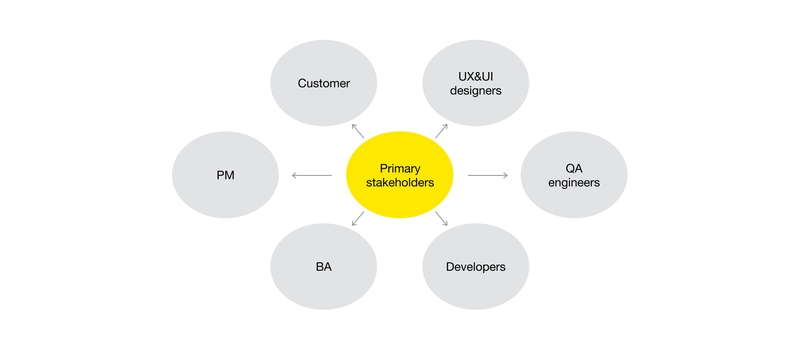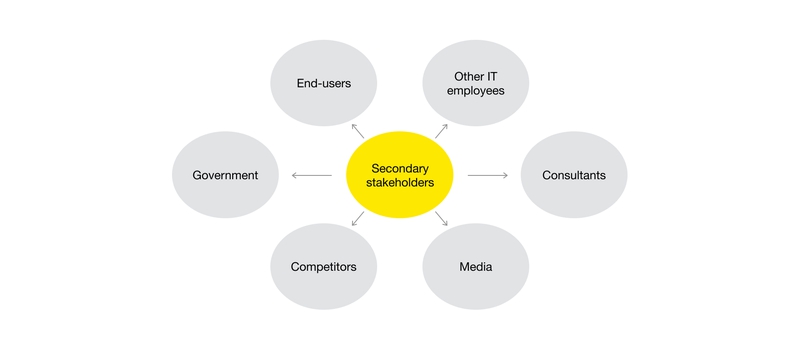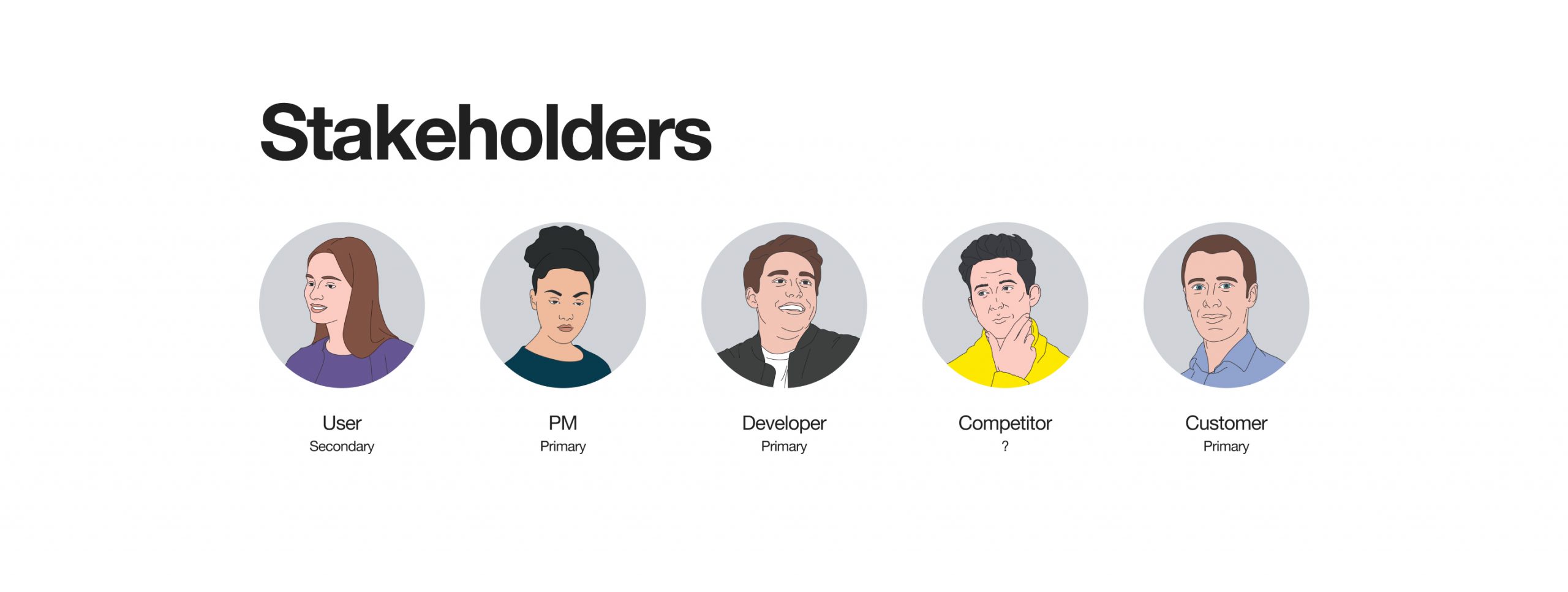The development of software solutions needs the identification of all requirements, laying the groundwork for project success. Engaging key stakeholders in the early stages of development helps you build a strong communication strategy, meet primary requirements, and avoid time and money waste.
The role of stakeholders in a software project
IT project stakeholders are individuals, groups, or organizations that are actively involved in a software project, can influence it due to their position, and whose interests may be affected by the success or failure of the project. Stakeholders can have different degrees of responsibilities and authority that may change throughout the software development lifecycle.
For example, end-users usually indirectly affect the project. However, if users take part in testing MVP, they may change their roles and directly impact the further project development processes.
Sometimes, competing expectations of different stakeholders can become a heated debate. However, stakeholders’ engagement is one of the most effective strategies to achieve high project results and meet your primary business goals.
All software development stakeholders can be divided into two groups: primary and secondary. Such classifying helps to prioritize the interests of groups involved in the project and improve decision-making. Who are the primary and secondary stakeholders in a software project, and what is their role in the development of the project?
Primary stakeholders in a software project
Primary stakeholders have a direct impact on your software project. They are people, groups, or organizations that have the strongest voice and can gain or lose their income. Knowing and understanding primary stakeholders’ interests can ensure high performance and the best decisions for your product.

-
Customers
Customers determine the main requirements and project scope as well as sign contracts with the main project performers. They always interact with the team, approve or supplement the plan with new implementation points.
-
Project Managers
Project Managers control the entire project creation process, considering the interests and needs of all stakeholders. Their main interest is to create a solid product on time and within budget, making customers satisfied. They lead a development team and supervise the project implementation processes, making necessary adjustments.
-
Business Analysts
A BA team analyzes the customer’s ideas, communicates with the development team, and determines project scope and requirements. They make predictions to understand the project budget and time as well as create project decomposition.
-
Development Team
Developers as stakeholders are responsible for timely software delivery and estimation. Based on their experience and innovation trends, the developers can provide stakeholders with advice on business idea implementation and quality estimation needed to understand the scope of work and resources needed. This group also includes QA engineers who define bugs to meet specified requirements and prevent failed user scenarios.
-
Designers
UI&UX designers make the product interface user-friendly and understandable. They understand that a user comes to the site or works with the application to solve a specific problem. Therefore, designers make customers get what they want quickly and easily.
Primary stakeholders can also be represented by project sponsors, marketing teams, business partners, suppliers, etc.
Secondary stakeholders in a software project
Secondary stakeholders have an indirect relationship with a software development process. They do not have any direct engagement with a project or a company but can indirectly affect decisions related to your software product and its reputation.
The role of secondary stakeholders should not be undermined because their identification is crucial for the continuous improvement of the product.

-
End-users
Every product has its target audience, whose needs and desires affect the design and functionality of the system. Users can be engaged as stakeholders in testing product beta-version to provide the initial feedback. They can point out missing features and contribute to user experience improvement.
-
Government
The state, represented by the regulatory authorities, can also be a stakeholder. Regulators adopt international standards that influence the development of a software product and impose fines for non-compliance with the rules.
-
Competitors
Competitors always implement new features and create industry trends affecting the market. Thus, your competitors can influence the prioritization of tasks creating new unexpected challenges to respond to.
Secondary stakeholders can also include the media, consultants, or IT company employees who are not working on the project.
Importance of Stakeholder Engagement in Software Development
In the world of software development, the importance of early stakeholder engagement cannot be overstated. Imagine embarking on a construction project without a solid foundation – the results would be disastrous.
Similarly, engaging key stakeholders from the inception of a software development project is not a mere formality but a strategic move that sets the tone for success. It goes beyond ticking a box in the project management checklist; it’s about laying a foundation that minimizes the risk of misunderstandings, aligns goals, and prevents wastage of time and resources.
The crux of this importance lies in the establishment of robust communication strategies. It’s not just about having stakeholders at the table; it’s about crafting communication strategies that are tailored to their needs, ensuring that their expectations are not only heard but deeply understood.
This early collaboration acts as a guiding compass, steering the project towards success and averting potential pitfalls. It’s about creating a shared understanding right from the beginning, minimizing the likelihood of veering off course.
Dynamic Roles of Stakeholders Throughout the Software Development Lifecycle
Stakeholders in a software project are not static entities with fixed roles; they are dynamic participants whose roles evolve throughout the software development lifecycle. Picture it as a theatrical production where each stakeholder takes on different roles in different acts.
For instance, end-users may start as indirect influencers during the requirements phase but can transition into active contributors during testing phases.
Understanding these role transitions is not just a matter of project management finesse; it’s crucial for effective collaboration. It’s about recognizing when stakeholders should be observers, providing valuable insights, and when they should be active contributors, guiding the project through critical phases.
This adaptability ensures a well-coordinated performance aligned with the project’s overarching objectives. It’s an acknowledgment that the dynamics of stakeholder involvement are not linear but require a nuanced understanding of their roles and contributions at different stages.
Challenges in Managing Competing Expectations Among Stakeholders
In the multifaceted landscape of software development, managing competing expectations among stakeholders is akin to navigating through a complex and heated debate. Conflicting visions and expectations often arise due to diverse priorities, perspectives, or interests. The challenge is not merely acknowledging these conflicts but actively addressing them.
This involves establishing open communication channels where stakeholders feel empowered to express their views. It’s about implementing conflict resolution frameworks that provide a structured approach to handling disagreements.
Transparent decision-making processes become essential in ensuring that conflicting interests are not swept under the rug but are addressed openly and objectively.
Successfully navigating these challenges turns potential discord into a catalyst for innovation. It’s an acknowledgment that divergent viewpoints are not roadblocks but opportunities for finding creative solutions. It’s about ensuring that the project stays on course despite varying stakeholder interests, transforming challenges into avenues for improvement.
Significance of Secondary Stakeholders in Software Projects
While primary stakeholders take center stage, secondary stakeholders operate behind the scenes, exerting indirect influence that is often overlooked. End-users, regulatory bodies, competitors, and other secondary stakeholders may not be front and center in project discussions, but their roles are pivotal.
End-users, for instance, contribute significantly to product refinement through beta testing. Regulatory bodies set standards that not only influence the development of a software product but can also impose fines for non-compliance. Competitors, always at the forefront of industry trends, can influence the prioritization of tasks, creating unexpected challenges that demand agile responses.
Acknowledging the impact of these secondary players is not just a nod to their existence but an understanding of their crucial roles. It’s about appreciating the unseen forces that influence product improvement and market positioning. It’s an awareness that comprehensive project planning must extend beyond the primary stakeholders to encompass the broader ecosystem that shapes the project’s success.
Best Practices for Stakeholder Communication and Management
Effective stakeholder communication and management are not theoretical concepts confined to textbooks but practical strategies that can make a tangible difference in the success of a software development project. Consider the following best practices:
Interactive Workshops and Meetings
Create spaces for two-way communication through interactive workshops and meetings. These sessions go beyond one-way information dissemination; they provide opportunities for stakeholders to voice their opinions, ask questions, and actively contribute to decision-making processes.
Feedback Loops and Iterative Processes
Embrace an agile approach by incorporating stakeholder feedback throughout the development process. This involves creating iterative cycles where stakeholders can provide input, allowing for continuous refinement of the product and ensuring that it aligns with evolving expectations.
Clear Documentation
Ensure that project documentation is not just a bureaucratic exercise but a tool for clarity and reference. Clear, concise, and accessible documentation serves as a shared reference point for stakeholders, reducing ambiguity and promoting a shared understanding of project objectives.
Stakeholder Workshops for Requirement Gathering
Engage stakeholders early in the process through workshops dedicated to gathering project requirements. This participatory approach not only ensures that their insights are considered from the project’s initiation but also minimizes the likelihood of misunderstandings later in the development process.
Establishing a Dedicated Communication Channel
Create a dedicated communication channel for stakeholder inquiries and feedback. This direct line of communication promotes accessibility and responsiveness, ensuring that stakeholders can easily reach out with questions, concerns, or valuable insights.
Risk Communication Planning
Develop a comprehensive plan for communicating project risks. Clearly articulate potential challenges, mitigation strategies, and contingency plans. This not only keeps stakeholders well-informed about the project’s risk landscape but also establishes transparency regarding potential obstacles.
Post-Implementation Reviews
Conduct post-implementation reviews with stakeholders to gather insights on what worked well and areas for improvement. This reflective process enhances the learning curve for future projects, strengthens the relationship between stakeholders and the development team, and provides valuable lessons for ongoing improvement.
Implementing these best practices is not a one-size-fits-all approach; it requires adaptability and customization based on the unique dynamics of each project.
However, the common thread among these practices is the commitment to fostering a dynamic and collaborative communication environment. It’s about recognizing that effective stakeholder communication is not a checkbox to mark off but an ongoing process that significantly contributes to the overall success of a software development project.
Who are stakeholders in a project
Stakeholders in a software project are people or organizations who have their goals, desires, and biases about software implementation. Identification of key stakeholders can help you more clearly see social connections, hidden dangers, and business prospects. The primary stakeholders are key players in a software project’s success, providing feedback, insights, and direction. Proper stakeholder management is crucial to meeting business and user requirements.
Regular communication with stakeholders helps Exposit Delivery Managers and development teams always meet primary project requirements and business goals. Contact us to discuss your idea and find the most effective solution for your business challenge.






